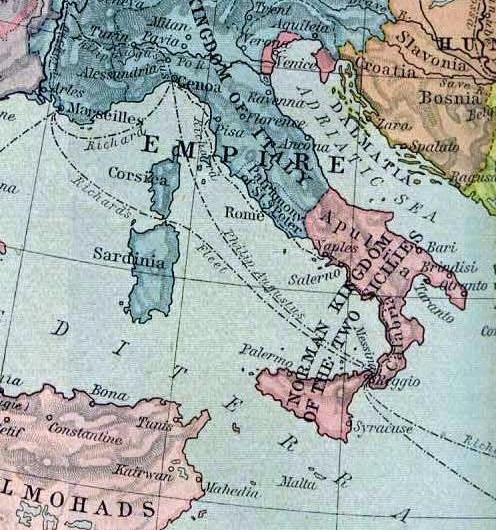Above: Italy in 1190 Common Era
SAINT WILLIAM OF VERCELLI (1085-1142)
Roman Catholic Hermit
His feast = June 25
friend of
SAINT JOHN OF MATERA (DIED 1139)
a.k.a. Saint John of Pulsano
Roman Catholic Abbot
His feast transferred from June 20
++++++++++++++++++++++++++++++++++++++++
I have detected a pattern common to many hermits: They seek solitude yet attract followers. It is good to seek to follow a holy person, a positive influence, for the polar opposite is to run with a bad crowd. But what about the holy hermit’s need for solitude? Today’s saints were such hermits.
St. John of Matera (died 1139) was born–where else?–at Matera, in Basilicata, in southern Italy. He joined an island monastery nearby, off the coast of Taranto, in the region of Apulia. His aloofness and austerity alienated other monks there, so he left for Calabria then for Sicily. Spending 2 1/2 years as a monk at Ginosa, St. John rebuilt a church. Unfortunately for the saint, he allegedly found a hidden treasure. This charge was enough for authorities to imprison him. Yet the saint broke out of jail and fled the area.
Next he encountered St. William of Vercelli (1085-1142). St. William was a nobleman from Vercelli, in the Piedmont region of northern Italy. His parents died when he was an infant, so relatives raised him. At age fourteen St. William made a pilgrimage to Compostela. Seven years later, at Melfi, in Basilicata, in southern Italy, he began to live as a hermit on Monte Solicoli. Once St. William began to make a pilgrimage to Jerusalem, but he abandoned it after robbers attacked him. He became a hermit at Monte Virgiliano instead. St. William attracted so many followers that he built a monastery there. And there St. John of Matera, a fugitive, joined the community. It was a strict community–too austere for many. So Sts. William and John, along with five followers, left for Monte Laceno in Apulia, in southern Italy. This community ended in fire. The hermitages destroyed, the saints went their separate ways.
St. John moved to Bari, where his effective preaching did not shield him from charges of heresy. So he returned to the community at Ginosa. Later he went to Monte Gargano, where he built a monastery and served as abbot.
St. William relocated to Monte Cogneto in Basilicata. Later he founded monasteries at Salerno, Conza, and Guglietto. While at Salerno St. William advised King Roger II of Sicily (reigned 1102-1154), whose empire ranged from southern Italy to northern Africa and who reformed the law and patronized science. St. William died at Guglietto.
Reading about lives of saints and organizing the material one has learned can be quite interesting. In this post alone I have had the opportunity to write about an empire and a jailbreak. Even better, I had a chance to ponder two men within whom still waters ran deeply. That was inspiring.
KENNETH RANDOLPH TAYLOR
MAY 20, 2012 COMMON ERA
THE SEVENTH SUNDAY OF EASTER, YEAR C
THE FEAST OF SAINT ALCUIN OF YORK, DEACON AND ABBOT
THE FEAST OF SAINT HELENA, MOTHER OF EMPEROR CONSTANTINE I
+++++++++++++++++++++++++++++++++++++++++++++++++++++++++++++++
O God, whose blessed Son became poor that we through his poverty might be rich:
Deliver us from an inordinate love of this world,
that we, inspired by the devotion of your servants
Saints William of Vercelli and John of Matera,
may serve you with singleness of heart,
and attain to the riches of the age to come;
through Jesus Christ our Lord,
who lives and reigns with you,
in the unity of the Holy Spirit,
one God, now and for ever. Amen.
Song of Songs 8:6-7
Psalm 34
Philippians 3:7-15
Luke 12:33-37 or 9:57-62
—Holy Women, Holy Men: Celebrating the Saints (2010), page 722


You must be logged in to post a comment.